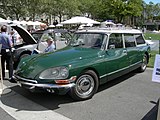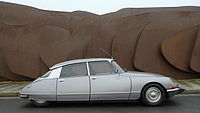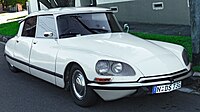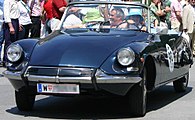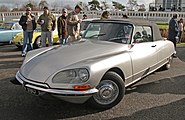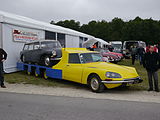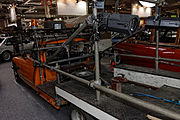Citroën DS
| Citroën D models | |
|---|---|
| Production period: | 1955-1975 |
| Class : |
Upper class Upper middle class |
| Body versions : | Sedan , station wagon , cabriolet , coupé |
| Previous model: | Citroën Traction Avant |
| Successor: | Citroën CX |
| 1st generation of models | |
|---|---|
|
Citroën DS |
|
| Production period: | 1955-1967 |
| Engines: |
Petrol engines : 1.9–2.3 liters (43–93 kW) |
| Length: | 4838-4990 mm |
| Width: | 1790 mm |
| Height: | 1470-1520 mm |
| Wheelbase : | 3125 mm |
| Empty weight : | 1150-1350 kg |
| 2nd generation of models | |
|---|---|
|
Citroën DS |
|
| Production period: | 1967-1975 |
| Engines: |
Petrol engines : 1.9–2.3 liters (43–93 kW) |
| Length: | 4874-5026 mm |
| Width: | 1803 mm |
| Height: | 1470-1520 mm |
| Wheelbase : | 3125 mm |
| Empty weight : | 1150-1350 kg |
The D models , commonly known as the or the Citroën DS , are a range of models from the French car brand Citroën .
When it was presented on October 8, 1955 at the Paris Motor Show, the long-awaited new Citroën model attracted attention from the trade press and visitors, but it also caused irritation. In the spring of 1957, the ID model series was added as a technically simplified version that had been adjusted for equipment.
The D models called ID, DS, Pallas and Break combined avant-garde design with an abundance of technical innovations in a unique way and represented a sensation. The D models were the first to have a central hydraulic system for suspension in a series vehicle ( Hydropneumatics ), brakes, gears and steering assistance ( power steering ) are used. Thanks to good aerodynamics, the avant-garde body shape enabled impressive performance and fuel consumption figures. Contrary to initial concerns, the complex hydraulic system proved to be permanently functional and the daring design was practical.
In their 20-year production period, the D models were basically produced unchanged. Her status as a technology and design icon is undisputed to this day.
In the period from October 4, 1955 to April 24, 1975, a total of 1,456,115 D-series vehicles were built.
Model history
The Citroën DS replaced the models of the Traction Avant series, which had hardly changed in appearance for 23 years . The design and technology of the new car represented great advances in comparison with its predecessors, but also in comparison with contemporary competing products. As with the previous model, the designer André Lefèbvre and the designer Flaminio Bertoni played a leading role in the development of this model . Paul Magès developed hydropneumatics .
When it was presented at the Paris Motor Show on October 5, 1955, just over 12,000 orders are said to have been counted on the evening of the first day. Assuming that the salon is open for eight hours per day, the necessary intake of 1500 orders per hour seems questionable. Insiders suspect a skilled marketing coup here.
The first D-model as DS 19 had 1911 cm³ displacement , 75 PS (about 55 kW) and reached a top speed of 140 km / h. For a normal sedan, that was a high value for the time it was released. Later top models reach over 185 km / h.
The D models were available from the factory as a four-door sedan (Berline) and in several five-door station wagon versions : the Break, Familiale and Commerciale versions differ in the number and arrangement of the rear seats. The station wagons had an upper and a lower tailgate section and the option of attaching two (identical) license plates to the rear so that the vehicle could be identified even when the lower section of the tailgate was folded down.
In the course of the long construction period there were the model groups (ascending) ID, DS, Pallas (based on DS) and Break (based on ID and DS) from the model series. As sedans, these were in particular the models DS 19, DS 20, DS 21, DS 21 ie, DS 23, DS 23ie; ID 19, ID 20, D Spécial, D Super and D Super 5. The two-digit number code in the model name indicates (approximately) the respective displacement of the engine in 100 cm³ (the DS 19 had a displacement of 1.9 liters, for example). The abbreviation ie at the DS 21 DS 23 IE and IE includes the use of electronic Bosch - Injection System ( D-Jetronic ) out.
The sedans of the DS models were available from 1964 as the luxury version “Pallas”. There was a small number of the two-door factory cabriolet (Usine), and over the years some special versions were added.
Name history
DS - La Déesse - The Goddess
The designation DS (in the German pronunciation: “De-es”) was a derivation or a play on words for the original type designations of the “D models”: Before the market launch, the internal designation was VGD, voiture à grande diffusion , meaning “vehicle with large Distribution / number of items ". From the various VGD versions, internally referred to as “D” with the corresponding number after it - D1, D2 etc. - the plural “Ds” became over time. At some point, Citroën probably became aware of the linguistic consonance of “(la) déesse”, “(the) goddess”, with the letter abbreviation; this play on words was then adopted for the model name. Similar word games were also possible with the model designation of other Citroën models: In French and German, the economy model “ID” is associated with the word idea (“idée”); the letter combination of the DS successor "CX" stands in French for the drag coefficient (German: c w ).
The DS
In French, the root word “auto” is classified as feminine (la voiture) ; In the German-speaking world, the DS was almost exclusively referred to as "the DS" in language, media and literature during the production period. In recent times, all the more the model series D, known practically exclusively as "DS", has achieved cult status (cf. in the sections Social Significance and Reception ), the feminine - no longer common with Francophone connoisseurs - has become increasingly popular also in the German-speaking area (La Déesse - The Goddess) .
Shark, frog and pike
Even at the same time, the name " shark " came up for the DS . This was due to the fact that this vehicle, even in its first model version, arouses the association of a shark's mouth when viewed from the front. In particular, the models of the first body version (1955–1962) were often referred to as the “frog”, and the front body was also named here. The car is also known colloquially in the Netherlands as "Snoek" - that is, pike.
technology
body
The structure of the body differed from almost all other cars of the time. The supporting structure of the D models was a platform frame welded to the body skeleton as a chassis ; the bodies of the Renault 16 , the Trabant and the Rover P6 were constructed similarly . Non-load-bearing parts such as fenders, hoods, doors and roof were bolted to the frame. To change a wheel, the rear fenders had to be dismantled after loosening a screw with the crank handle. In 1962 there were the first small retouching of the front.
André Lefèbvre was an advocate of using plastic and aluminum to reduce weight. The roof of the sedan is made of fiberglass-reinforced plastic (the break models are made of steel). 100 kilograms of aluminum were used, as was the case with the bonnet, which was the largest mass-produced aluminum body part at the time; Bumpers and moldings were made of stainless steel and aluminum.
In 1967 the front was extensively redesigned, since then all D models have had double headlights behind a glass front. The principle implemented in the Panhard 24 was used - the brand was taken over by Citroën in 1967. In the more expensive models with cornering lights , the high-beam headlights swiveled synchronously with the steering angle and illuminated the corner. These models also had a device connected to the axles via Bowden cables for dynamic control of the headlight range when the vehicle nods when driving over bumps, when accelerating or braking. The compensation took place via the control of the hydropneumatic valves.
With the facelift in September 1967, the length and width of everything changed, both for the sedans and the Break station wagon models. A special design feature of the D series are the different track widths at the front and rear, which were also enlarged in October 1968.
Dimensions
- limousine
| dimension | until Sept. 1967 | from Sept. 1967 |
|---|---|---|
| Length over all | 4838 mm | 4874 mm |
| Width over everything | 1790 mm | 1803 mm |
| Height above everything | 1470 mm | 1470 mm |
- Station wagon (break)
| dimension | until Sept. 1967 | from Sept. 1967 |
|---|---|---|
| Length over all | 4990 mm | 5026 mm |
| Width over everything | 1790 mm | 1803 mm |
| Height above everything | 1520 mm | 1520 mm |
- all types
| dimension | until Oct. 1968 | from Oct. 1968 |
|---|---|---|
| wheelbase | 3125 mm | 3125 mm |
| Front track | 1500 mm | 1516 mm |
| Rear track | 1300 mm | 1316 mm |
Hydropneumatics with central hydraulic system
The hydropneumatic suspension in conjunction with the high-pressure hydraulic system was unique for the time . The internal disc brakes at the front, the dual-circuit brake system (one brake circuit each for the front and rear axles) with load-dependent high - pressure brakes, which were supplied with pressure via the central hydraulics, as well as the semi-automatic transmission and steering, were new.
The hydropneumatics make it possible to vary the ground clearance of the car. When the engine is switched off, the decreasing pressure in the hydropneumatic system slowly lowers the vehicle to its lowest position, the body then rests on rubber buffers. If you start the engine, the car rises several centimeters. The hydropneumatics work automatically as a level control and keep the ground clearance constant, both with different loads and with changing driving conditions. A lever can be used to select the normal driving height, two higher driving positions and a repair height, as well as lowering the vehicle manually to the rest position. Because of this ability, the DS without jack but was with Jack Stand delivered. Rolls-Royce and Mercedes-Benz acquired a license for the Citroën patent. Rolls-Royce obtained the parts directly from Citroën.
Hydraulic braking system
- DS models with brake accumulator and control system
The distinguishing feature of the DS models is the distinctive "brake mushroom", a rubber button for operating the brake. This is mounted on a roller-mounted brake distributor plate. With only a small “pedal travel”, the foot force acting on the brake button is transferred via the plate to the brake pressure distributor and from there to the front and rear brake circuit with different pressure forces via a system of control valves. The rear brake circuit is connected to the suspension elements of the rear axle, the front has its own brake pressure accumulator. In the event of a loss of pressure, for example due to a leaky line, there is still enough hydraulic pressure via the pump system; even in the event of a total failure, the vehicle can be brought to a standstill using the front brakes - with the residual pressure in the two pressure accumulators.
- Simple D models with safety valve and brake pressure regulator
The distinguishing feature of the ID, D Spécial and D Super / 5 models, on the other hand, is the presence of a conventional brake pedal with an extremely short pedal travel and a simplified brake system connected to the central hydraulics. It consists of a safety valve and a brake pressure regulator.
- Parking brake
The parking brake acts conventionally on the front axle via brake cables. With the DS variants it is operated with a pedal, with the ID and D-Spézial / -Super variants partly with a handle; is solved in both cases with a handle.
steering
The suspension of the front wheels was designed in such a way that a disturbance force lever arm of zero resulted (center-axle steering), so that no disturbance forces could act on the steering. Another characteristic feature was the single-spoke steering wheel, which is held in place by the curved steering column that "flows out of the dashboard like toothpaste from a tube". Since there were no seat belts at the time, the safety consideration behind this was that the steering wheel could be deformed best in the event of a collision with the driver and thus not be able to impale him.
Most of the models have a hydraulic rack and pinion steering, supplied via the central hydraulics.
More novelties
In addition to the technical innovations already explained, there were a few more:
- The D models were one of the first series production cars to be equipped with radial tires developed by Citroën owner Michelin .
- Instead of a jack, a support with an insertable pin was included. The hydraulic system was used to change the wheel: pump up the vehicle to the highest position, attach the support, insert the pin, lower the vehicle manually in the rest position. The anti-roll bars ensure that the wheels on the supported side lift off the ground.
- Horn with two strengths, the first switches two electric horns , the second stage also switches a two -tone horn with compressor drive, both are operated with the same lever over two switching stages.
- Semi-automatic with hydraulic gear preselection. The gear lever was on the top of the steering column.
Classification in the model range
The D models replaced several vehicles of different sizes and engines, namely the large, six-cylinder 15 CV and the normal and the light (smaller) 11 CV with four-cylinder. During the development of the engine for the DS there were problems, as a result of which the car was not equipped with a six-cylinder as planned, but with the slightly modified four-cylinder from the 11 CV. The broad graduation of the previous models now had to be continued by a single basic model, with different equipment and engine options (DS, ID). There was a considerable gap between the D models and the small car 2 CV (referred to in German and Austrian vernacular as "Ente"), which was only narrowed in 1961 with the Citroën Ami 6 based on the 2 CV and the Ami 6 Break In 1970 with the appearance of the GS (" Grande Série ") a full range of models existed.
The DS had a unique position up to the appearance of the GS because of the hydropneumatics, which are very complex and at that time overwhelmed many workshops that were only used to conventional designs.
The economy versions ID and D Spézial / -Super were technically simpler, they had the same body, but differed in many details from the DS. The uniform bodywork for two vehicle categories arranged in different segments (upper class and today's upper middle class) was not unusual, for example, it was also used by Mercedes-Benz since 1954 and later also by Opel .
Dashboard of an ID 19 B (1969) with the typical single-spoke steering wheel, tape speedometer and seats covered with Helanca
Model history
Overview
|
DS models
|
ID / D special / D super models
|
Detailed development of all models
- 1955: October 6th: Presentation of the DS 19
- 1956: Spring: the ground clearance can be manually adjusted from 9 to 28 centimeters
- 1958: Presentation of the Kombi Break
- 1959: New design of the rear fenders: longer and rounded, with now embedded rather than attached reflectors
- 1960: Air outlets on the front fenders 1960 to 1962
- 1960: August: Changeover of the electrical system from 6 to 12 volts
- 1961: Presentation of the convertible
- 1961: New dashboard made of sheet metal and synthetic leather instead of plastic as before
- 1962: 2nd series with a redesigned, more aerodynamic front with a closed apron and rubber buffers on the bumper
- 1964: Change of synthetic hydraulic fluid from HF Rouge LHS (red) to LHS2 (colorless)
- 1965: September: new engine with five-bearing crankshaft and reduced stroke ratio
- 1965: Wheels with five screws instead of a central lock
- 1965: Change of the tire size from the previous 400 to 380
- 1965: Changes to the front end, whereby the air intakes of the brakes below the bumper became wider and shorter
- 1966: Autumn: Change to mineral hydraulic fluid on LHM (green)
- 1967: Autumn: new front with headlights behind glass
- 1967: September: Swivel headlights (the internal high-beam headlights) for Pallas and Cabrio as standard, available for an extra charge for ID and normal DS
- 1968: September: all German and Austrian DS equipped with swivel headlights
- 1968: September: new black dashboard, electric windscreen washer
- 1968: more comfortable seats with higher, continuously adjustable backrests
- 1969: October: new dashboard and introduction of round instruments
- 1971: Autumn: Recessed door handles are introduced
- 1973: April: new plant in Aulnay-sous-Bois
- 1975: April 24th: the last DS sedan rolls off the assembly line
- 1977: End of production of the station wagon version
Detailed development of DS 19 and DS 20
- 1955: DS 19 new with revised engine from the 11 CV, triple bearings, aluminum cross-flow cylinder head, 1911 cm³, 75 SAE-PS at 4500 rpm
- 1961: Spring: engine output increased to 80 PS (83 SAE PS) at 4250 rpm
- 1961: new dashboard (a bit more traditional)
- 1962: Autumn: new, smoother front design for better aerodynamics
- 1963: February: also available with manual gearshift
- 1964: September: Pallas equipment available, recognizable by the additional iodine headlights, trim strips
- 1964: Belts available on the front seats
- 1965: new engine: DY with 1972 cc, 84 hp at 5250 rpm, available from 1965 to 1968
- 1968: Variation to the DS 20 with a DY2 engine with 90 hp at 5750 rpm
- 1971: engine output increased from 90 to 98 hp (DY3)
Detailed development of DS 21 and DS 23
- 1965: DS 21 new with DX engine with 2175 cm³, five bearings, 100 HP at 5500 rpm, automatic height adjustment of the headlights
- 1968: new DX2 engine with 104 hp
- 1969: October: available in parallel as DS 21 ie with electronically controlled injection ( Bosch D-Jetronic ), DX3 engine with 120 hp at 5250 rpm
- 1970: mechanical five-speed gearbox available as an option
- 1971: fully automatic three-stage BorgWarner transmission available on request
- 1972: Variation to the DS 23 with engine DX4 and carburettor with 110 hp and DS 23 ie with engine DX5 with injection and 126 hp
Detailed development ID, D Spécial and D Super / 5
The ID and D-Super models are more simply equipped compared to the DS models. This applies to the exterior of the car, the interior and the technology used.
The engine output of the first basic model ID 19 Normale was further reduced to 58 HP (63 SAE-HP) compared to the ID 19 Luxe - here the unchanged engine with parallel flow cylinder head from the predecessor 11 CV was used.
The other IDs, like the DS, had throttled the modernized engine, but with simpler carburettors and lower compression, initially to 66 SAE-PS (ID 19).
- 1957: Presentation of the ID 19 in May
- 1960: August: Change to 12 volt on-board voltage
- 1960: October: available with hydraulic power steering on request.
- 1961: Herbst: high pressure brake (simpler design, still with pedal operation)
- 1964: engine with 70 hp
- 1965: 74 hp engine
- 1966: only now new generation of engines with 78 hp with five bearings and short stroke
- 1966: Conversion to LHM hydraulic fluid
- 1967: Autumn: new front with headlights behind glass
- 1968: ID 20 available now with 90 hp; however, the ID 19 will continue to be produced
- 1969: ID 19 becomes D Spécial (colored roof)
- 1969: ID 20 becomes D Super
- 1970: September: D Super is available with a five-speed gearbox on request
- 1970: Hydraulic power steering becomes standard on the German and Austrian D Super
- 1971: Autumn: recessed door handles; D Super with 98 hp
- 1972: D Super 5 replaces the D Super in Germany and Austria; the 104 hp engine and the five-speed gearbox from the discontinued DS 21 are used here
- 1972: The D Spécial receives the engine of the D Super with 98 HP
Citroën ID 19 US version from 1969, still without side marker lights but sealed beam headlights
Citroën D Spécial 1969-1975 (right-hand drive in Australia, wiper gear geared towards the driver)
Special bodies
On the basis of the DS - and more rarely the ID - a number of different special bodies have been implemented. They include convertibles, coupés, special sedans and special commercial vehicle bodies such as ambulances and delivery vans.
Cabriolets
The best-known and most popular special versions on the classic car market are the convertibles. There are convertibles built by Citroën (usually called Usine ), convertibles built by Ateliers Henri Chapron (Chapron) and custom-made convertibles.
Factory convertible "Usine"
The Usine Cabriolet was manufactured in the Henri Chapron workshop from September 1960 to August 1971 for Citroën . The design of the factory cabriolets followed a design by Flaminio Bertoni . The vehicle was designed as a four-seater convertible. When closed, the soft top reached up to the side of the windows of the front doors; So there were - unlike some customer versions of Chapron - no rear side windows. The rear fenders were one-piece from the start; so they had no weld seam in front of the rear wheels. This differentiated the factory convertible from some of the early customer convertibles manufactured by Chapron. The front section went through the same development over the years as the sedan.
Citroën completed the order for the production of the Usine convertible in the summer of 1971. By then, Chapron had built 1,219 convertibles for Citroën based on the Citroën DS and 106 other copies with ID technology. By 1974, at the request of customers, around seven convertibles were built, stylistically matching the factory model.
Cabriolets "Chapron"
In addition to these factory convertibles, which have changed little over the years, Chapron created a number of other convertibles, some of which differed considerably from the factory models. In contrast to the factory convertibles, Chapron usually used a windshield six centimeters lower for his own models; however, the standard, high front window was also used on some of the models at the customer's request. Between 1958 and 1970, around 120 pure Chapron convertibles were produced in five series, which were available in different versions. These included the four-seater convertibles La Croisette (1958 to 1962; 52 copies) and Palm Beach (1963 to 1970; 30 copies) as well as the 2 + 2-seater model Le Caddy (1960 to 1968; 34 copies), which is a tighter cut Has convertible top.
More convertibles
In addition to the factory cabriolets and Chaprons customer versions, numerous other body manufacturers produced other convertibles based on the Citroën DS, but only a few copies or as individual pieces were produced. They included four-door Citroën DS Cabriolets from Heuliez . The Stuttgart company Reutter, which was later renamed RECARO , developed a four-door convertible based on DS in 1960 on behalf of the German Citroën branch, which had an elaborate convertible top mechanism and was realized in seven copies. A few convertibles were supplied by the Beutler brothers in Thun in 1959 and 1960 . Autenrieth in Darmstadt created a design for a DS convertible; its realization is not proven.
Coupes from Chapron
In parallel to the convertibles, Henri Chapron also offered a number of different coupés based on the DS, which - apart from the fixed roof - corresponded stylistically to his convertibles. The Le Paris (1958-1960; nine copies) and the Concorde (1960-1965; 38 copies) were closed versions of the four-seater convertible Croisette and the Palm Beach; the same applied to the Le Léman (1965–1972; 25 copies), which, however, had a flatter C-pillar. The Le Dandy (1960 to 1968; 49 copies), on the other hand, was the coupé version of the 2 + 2-seater Cabriolet Le Caddy. Unlike the four-seater coupés, it had no rear side windows, but a very wide B-pillar.
Other coupés were made by Barbero in Italy and Pichon-Parat in France , among others . Unlike the Chapron Coupés, they were based on a shortened DS chassis.
Special sedans
Chapron built several four-door sedans based on the DS between 1965 and 1974, each with its own lines. One of them was the DS Présidentielle, manufactured in 1963 , a 6.40-meter-long representative vehicle with heavily distorted lines and a notchback that Charles de Gaulle occasionally used on official occasions. The presidential was sold in 1976. Other sedans were the Majesty (25 copies) and the Lorraine (4 copies).
commercial vehicles
The station wagon ( French Break ) had the same wheelbase as the sedan (3125 mm), the greater length was achieved by a larger rear overhang. With a loading area of around two meters with the rear seat folded down or removed, this model was also suitable for use as an ambulance without any body modifications .
Individual bodywork companies in France, of which (Pierre) Tissier is the best known, converted the combination models into large-capacity transporters with two rear axles as well as increased and extended loading space. These operated between Paris and the Ruhr area and / or and Frankfurt to transport newspapers between Germany and France by express service.
DS Break as a Danish ambulance in the Technical Museum Denmark
Citroën DS as a five-axle tire test vehicle Mille Pattes from Michelin (second model version)
Citroën DS as a pick-up (conversion of a Break; after 1967)
Further special constructions and individual pieces
The DS was also often used as the basis for sometimes curious custom-made products, including a DS convertible converted into an amphibious vehicle . An ID-19 limousine as a swimming car circled Heligoland. In addition to being converted into a four-axle tow truck, the Mille Pattes , a five-axle tire test vehicle from Michelin , is one of the best-known special vehicles.
Social relevance

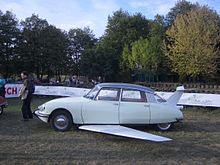
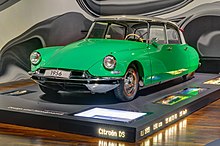
The French President Charles de Gaulle used a DS on all official occasions. On August 22, 1962, a DS was instrumental in saving his life when he was assassinated in Petit-Clamart . Thanks to the hydropneumatics, the car was able to continue on three wheels despite a blown rear tire. The assassination, which was recreated in the political thriller The Jackal , contributed to the myth of the DS.
In its time, the DS was considered a car for non-conformists , especially in the export markets, because of its design and revolutionary technology .
In October 2005, on the occasion of the 50th birthday of the DS model, owners from numerous countries met with around 1,600 "goddesses" in Paris.
Although neither the elaborate hydropneumatics nor the design (at least outside of the Citroën house) have found major imitators, the DS is a milestone in automotive history. With the phasing out of the Citroën C5 model, hydropneumatics and hydractive suspension are history in the entire PSA group.
The concept artist Gabriel Orozco removed the body of a DS and welded it back together in the shape of an arrow on a narrower frame . The "sculpture" can no longer drive because the Orozco engine has been rendered unusable. He exhibited “La DS” for the first time in 1993 at the Musée d'Art Contemporain (MAC) in Marseille, where it was bought by the national Collection Fonds national d'art contemporain (FNAC).
Cinematic reception
DS starred in many films, for example in Sharp Bends for Madame with Louis de Funès , where the car even drove along the Seine as an amphibious vehicle in one scene , and Fantômas , also with de Funès, where a DS used by the villain is in transformed into an airplane, or into French Connection - focal point Brooklyn and its successor French Connection II . In some French films of the film noir genre, a black DS is typically driven by criminals. As The Ice Cold Angel , Alain Delon only steals the luxury version DS Pallas. In the comedy Das Superhirn from 1969, Jean-Paul Belmondo drives a DS that breaks apart behind the front seats during a chase and then continues its journey thanks to front-wheel drive. In the film The Japanese and the Goddess (English original title: The Goddess of 1967 ) from the year 2000, the DS is the title motif. In Crossing Jordan - Pathologist with Profile , Miguel Ferrer drives in his role as Dr. Garret Macy a Citroën DS. In The Mentalist , lead actor Simon Baker also drives a DS in the role of Patrick Jane . In the television series Dr. Stefan Frank - The doctor whom women trust (1995–2001) drove Sigmar Solbach as Dr. Frank has a DS with a folding roof . In the multi-Oscar-nominated film Dame, König, As, Spion (2011), the character George Smiley played by Gary Oldman drives a DS 21 Pallas. A DS 19 is driven by Anthony Head as guard Rupert Giles in the series Buffy the Vampire Slayer . In Helge Schneider's film 00 Schneider - Inspector 00 Schneider drives a Citroën DS in the tropic of the lizard .
How futuristic the design of the car still is today can be seen in its use as a prop in several current science fiction productions . A slightly different DS can be seen in a shot of Back to the Future II as a floating taxi without wheels, as well as in the opening credits to the TV series Eureka . In an episode of the 2005 second season of the Battlestar Galactica series , a DS can be seen in an underground car park. In Gattaca a DS convertible serves as a means of transportation.
Contemporary and current reception in flux
The French structuralist philosopher Roland Barthes wrote in 1957 in an essay in Myths of Everyday Life about the "Déesse":
“The new Citroen obviously falls from the sky in so far as it initially presents itself as a superlative object. It should not be forgotten that the object is the best messenger of supernature: there is in the object both a perfection and a lack of origin, something closed and something shiny, a transformation of life into matter (matter is more magical than life) and ultimately: a silence that belongs to the order of the wonderful. The "Déesse" has all the traits (at least the public is beginning to ascribe it with one accord) of those objects that have descended from another world, from which neomania of the 18th century and that of our science fiction were nourished: the "Déesse" is first of all a new Nautilus .
[...] The "Déesse" is clearly visible as a price tag on the discs, the sheet metal only provides the score. The panes are no longer windows here, no openings broken into the dark body, they are large expanses of air and emptiness and have the glistening curvature of soap bubbles, the hard thinness of a substance that is more insect-like than mineral.
So it is a humanized art and it is possible that the "Déesse" marked a turning point in the mythology of the automobile. So far, the superlative car was more reminiscent of the bestiary of power. "
In 1960, five years after the first public DS presentation, the trade magazine auto, motor und sport said:
“'When the curtains were pulled, the DS was presented to an audience that hastened to split into two parties. Some enthusiastically applauded the progress that seemed to have come to them personally, while for others the futuristic design and the hydraulic system were more than simply being able to accept it, accustomed to a development process in crawl gear ' wrote the magazine. "
On April 11, 2005, 50 years after the presentation of the DS, Ö1 broadcast a radio feature in the series Moment - Leben heute , which states, among other things:
“It was a minor sensation at the 1955 Paris Motor Show. The Citroen DS was presented to the amazed audience for the first time. Hardly any other manufacturer could come up with a similarly unusual vehicle. Citroen knew this, unceremoniously raised its new creation to Olympus and simply called the new car 'the goddess' (DS = 'Déesse'). Even if the reactions were mixed, the new car was fascinating. "
literature
contemporary
- The new Citroën DS 19. In: Automotive technology . 1956, No. 2, pp. 47-48.
- Alexander Spoerl : Citroën - Car or Progress? In: Der Spiegel . No. 18 , 1957, p. 44–50 ( online - May 1, 1957 , driving report on “the 'DS 19'”).
- Roland Barthes: The new Citroën. In: Myths of Everyday Life. Roland Barthes (Ed.), 1957.
- Printed in: Roland Barthes: Myths of everyday life. Complete edition. Translated from the French by Horst Brühmann. Suhrkamp Taschenbuch (Volume 4338), Berlin 2012, ISBN 978-3-518-46338-3 .
- Test: Citroën DS 19. In: Automotive technology. 1960, No. 10, pp. 404-409; 1960, No. 11, pp. 444-447.
- Mark Buchmann (Ed.): Model case Citroën - product design and advertising. Accompanying volume to the exhibition in the Kunstgewerbemuseum Zurich and in the Werkkunstschule Hannover , 1967.
after production cessation
- Paul Schinhofen: Revolution as a tradition. Citroen engineers always two steps ahead. In: mot Die Autozeitschrift . Issue 13, 1981, pp. 76-80.
- Walter drafter : Citroën ID / DS 1955–76. (= Schrader-Motor-Chronik. Volume 3). Motorbuch-Verlag, Stuttgart 1986, ISBN 3-922617-11-5 .
- Hans Röder: high pressure zone. From the Citroen DS to the XM. In: Everything about the Citroen XM. In: mot Die Autozeitschrift. mot special section in issue 22, 1989, pp. 89ff., pp. 104-107.
- John Reynolds, Jan de Lange, Rein van der Zee, Paul Debois: The Original. Citroën DS. All DS and ID models from 1955–75. Heel-Verlag, Königswinter 1997, ISBN 3-89365-616-2 .
- Hans Otto Meyer-Spelbrink: Citroën DS. The most unusual car ever. 2nd Edition. Podszun Motor Books, Brilon 2003, ISBN 3-86133-321-X .
- Ulrich Knaack: The DS driver, the unknown being. In: Ulrich Knaack, Halwart Schrader (ed.): Citroën-Jahrbuch 2005. Volume 1. FGV-Verlag, Hannover 2004, ISBN 3-00-013667-3 , pp. 80–91.
- Immo Mikloweit (Ed.), Daniel Puiboube: The New Large Citroën DS Book. Illustrated book. Heel-Verlag, Königswinter 2005, ISBN 3-89880-492-5 .
- Thibaut Amant, Ulrich Knaack (German editing), Daniel Denis (photos): Citroën DS. The divine car of the century. Illustrated book. Motorbuch-Verlag, Stuttgart 2007, ISBN 978-3-613-02750-3 .
- Rudy A. Heilig: Citroën DS & ID. All models 1966-1975. (= Series Praxisratgeber Klassikerkauf. ) Heel-Verlag, Königswinter 2009, ISBN 978-3-86852-083-5 .
- Rudy A. Heilig: The Essential Buyer's Guide Citroën DS & ID. Veloce Publishing, Dorchester 2008. (English)
French
- Jacques Borgé, Nicolas Viasnoff: L'Album de la DS. ÉPA - Éditions Pratiques Automobiles, Paris u. a. 1983, ISBN 2-85120-175-1 .
Movies
- The Citroën DS 19 - "The Goddess". Documentary, France, 2006, 26:31 min., Script and director: Danielle Schirman, production: arte France, series: design , first broadcast: October 6, 2006 by arte, summary by arte, ( Memento from April 18, 2013 in the web archive archive.today ), online video part 1 , part 2 , part 3.
- Goddesses are immortal - Les DS sont immortelles. Documentary, Germany, 2007, 41 min., Script and direction: Holger Möllenberg and Christoph Simon , production: motum-film, DVD edition: September 1st, 2007, synopsis by Christoph Simon and motum-film. ( Memento from February 22, 2016 in the Internet Archive )
- 1971 Citroën DS. Documentary, USA, 2015, 24:25 min., Book and moderation: Jay Leno , series: Jay Leno's Garage , Internet publication: January 11, 2015 on YouTube , online video.
- Car icons: Citroën DS - The floating goddess. Documentary, Germany, 2018, 29:46 min., Script and director: Thomas Eberding, production: SWR , series: Auto-Ikonen , Geschichte & Entdeckungen , first broadcast: July 19, 2018 on SWR television , synopsis by ARD , online video from SWR.
Web links
- le Danchorama - all the colors of the DS on nuancierds.fr.
- Sebastian Renz: Pallas of the Republic - French people supporting the state. Citroën DS and XM in the driving report. In: auto motor sport / Motor Klassik . December 8, 2010.
- Detailed model history. In: Franzose.de
- Purchase advice Citroen DS. In: Traeume-wagen.de
- Technical data of various DS models. In: Motorclassic.at
Individual evidence
- ↑ a b c d e f g h i j k l m n o p Citroën D. Volume 217/218 from the series of repair instructions. Verlag Bucheli / Paul Pietsch, Zug [after 1972], ISBN 3-7168-1282-X . (Note: This edition does not have a year. The manufacturer data for the models listed on pages 4–5 ends in October 1972, which results in the classification after 1972.)
- ↑ Test: Citroën DS 19. In: Motor Vehicle Technology , 1960, No. 10, pp. 404-409 and 1960, No. 11, pp. 444-447.
- ^ Jacques Borgé, Nicolas Viasnoff: L'album de la DS.
- ↑ See e.g. B. Michael [name]: My DS story! In: Reports section on the website of the OECC - Austrian Citroën Club, undated . Retrieved November 28, 2015. Looking back on a conversation in 1964 (when the first model version was still on sale): “[...] 'Finally a shark' I meant; 'No no, it is unfortunately much too expensive and too prone to repairs …… the hydraulics are always broken and nobody can repair them …… it will be a Ford 20 m, but next time, when we are finished building the house, it will be a shark Mama wants it because it's so elegant …… 'This conversation and the Ford purchase took place in the autumn of 1964. However, my father never bought a shark (of course a DS was meant). [...] "
- ↑ Michael Pekler: The shark turned fifty. In 1955 the Citroën DS was presented at the Paris Motor Show: since then it has been said to have been a car for connoisseurs and bon vivants. In: derStandard.at , April 11, 2015, accessed on August 1, 2018.
- ↑ a b c d e radio feature by Matthias Däuble: The goddess on earth: The shark turned 50. In: Ö1 , Moment - Leben heute , April 11, 2005, 5:25 pm, accessed on August 1, 2018. " A groundbreaking modern car was unveiled at the 1955 Paris Motor Show. The Citroen DS was cult from the start, not a mass-produced vehicle, more a car for connoisseurs and bon vivants. Louis de Funès made the DS immortal on screen. "
- ^ Horst & Jörg: DS Usine: Citroën DS convertible 1960–1971. In: jds-parts , accessed on August 1, 2018.
- ↑ With regard to the designations, the design features and the production figures, cf. the representation in Meyer-Spelbrink: Citroën DS , p. 72 ff.
- ^ Gaisbergrennen Salzburg 2004. Overall ranking. ( Memento from September 24, 2015 in the Internet Archive ). Starting number 80, position 67, Citroen DS 21 [Chapron Cabrio], built in 1967. In: salzburg.com , June 12, 2004, (PDF, 5 pages; 633 kB).
- ↑ Cf. Two Heuliez convertibles in Wikimedia Commons.
- ↑ Meyer-Spelbrink: Citroën DS , p. 83.
- ↑ Meyer-Spelbrink: Citroën DS , p. 68.
- ↑ The Pichon Parat Coupé had a modified front section, for which Panhard headlights were used. Illustration of the “Pichon-Parat” coupé. In: citroenet.org.uk , accessed August 1, 2018.
- ↑ With regard to the designations, the design features and the production figures, cf. the representation in Meyer-Spelbrink: Citroën DS. Pp. 72ff, 88 and 90.
- ↑ Interesting body variants for the Citroen ID Ia. In: Motor vehicle technology , 1960, No. 8, p. 322.
- ↑ The magazine auto, motor und sport describes Kurt Fähnrich's amphibious vehicle in issue 25 of 1980.
- ↑ ID 19 as Schwimmwagen (English summary of another article) on citroen.cappyfabrics.com , accessed on August 1, 2018.
- ↑ 55 years of the Citroën DS. Fallen from the sky. In: n-tv , October 6, 2010, last sentence.
-
↑ Gabriel Orozco. La DS. 1993. In: MoMA , accessed on July 24, 2019.
Video: La DS Gabriel Orozco 1993 in MAC , 1:50 min., Published on September 8, 2014. -
^ Locations of the exhibits in the MAC: Musée d'Art Contemporain / Livret jeune public. In: culture.marseille.fr , June 16, 2017, (PDF; 2 p., 2.1 MB), accessed on July 24, 2019.
'Auto-nom' opens up a new perspective on the car. ( Memento from August 1, 2018 in the Internet Archive ). In: Rheinische Post , September 22, 2003, mention of Gabriel Orozco's object “La DS”. - ↑ Quoted from essay by Roland Barthes: Mythen des Alltags. edition suhrkamp , one-time special edition, Berlin 1996. Excerpt from: The new Citroën. In: Prova - magazine for automotive avant-garde , undated [13. June 2001 according to source text], accessed on August 1, 2018.
- ↑ “Roland Barthes' myths of everyday life have long since become myths themselves. In his provocative, playful studies of society, he decodes phenomena such as [...] the divine qualities of the Citroën DS. […] “Suhrkamp taschenbuch, volume 4338, cover picture of the book with several DS and table of contents: online on the publisher's website, accessed on August 1, 2018.














